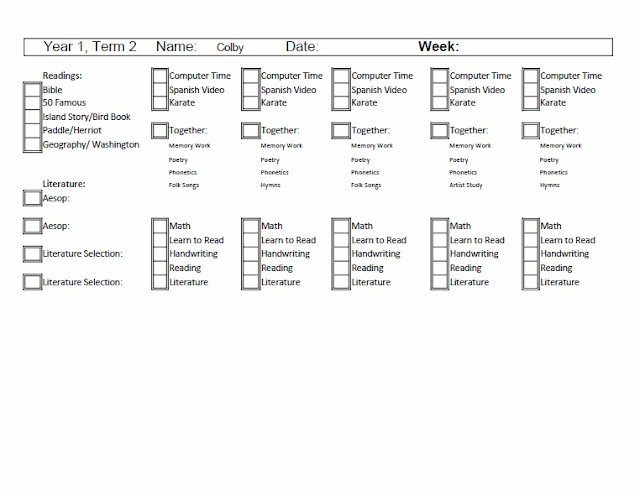So just what is "Kathy's Method?"
Here are links to her posts on the AmblesideOnline Forum and her blog explaining in detail. Briefly, the idea is to make a list with daily and weekly items to be checked off, and instead of planning out each book to be read on each day, there is a certain number of books for each day, divided into categories which the child chooses from on that day. The order and timing of each item on the daily and weekly lists are for the most part up to the child.
What Changes Did I Make?
I chose to use a paper planner that can be saved to document the work we did each day and week. We have to keep our attendance records, so with the planner I know exactly which days we did school each year. I also added a bit more structure for some of the kids as far as what subjects were done when. Some of my kids needed a bit more support, so instead of choosing from the whole day's work, they have a certain set of items to be done before a natural break in the day (like snack or a meal or "together time.") They can choose from that set instead of the whole list, which was overwhelming some of them into choosing nothing at all.
Here is my 6 year old's planner for Year 1, term 2. Along the left side the readings for each week are listed. The remaining five columns are for each day of the week. Along the top I can add the date and school week for my record keeping.
 These are the books for the term. At the beginning of each term, while I am planning, I figure out how to divide the books up into categories of 4 or 5 items each. For the older kids, there may be 5 categories along this side. For year 1, I only have 2. These categories then correspond with a assignment in the daily list.
These are the books for the term. At the beginning of each term, while I am planning, I figure out how to divide the books up into categories of 4 or 5 items each. For the older kids, there may be 5 categories along this side. For year 1, I only have 2. These categories then correspond with a assignment in the daily list.  The daily list is the part of the schedule the children use each day. It is mostly the same each day, with a few variations. I usually "chunk" each section of the day around something we all do together- snack, together time, lunch. In this example, my year 1 child has a few things he can do independently in the first section of the day. Together time happens with everyone else at snack time. Later, when the toddler is taking a nap or I have some free time we work on the second set of items together.
The daily list is the part of the schedule the children use each day. It is mostly the same each day, with a few variations. I usually "chunk" each section of the day around something we all do together- snack, together time, lunch. In this example, my year 1 child has a few things he can do independently in the first section of the day. Together time happens with everyone else at snack time. Later, when the toddler is taking a nap or I have some free time we work on the second set of items together. Here is an example of a scheduled reading and it's corresponding book. When the child reads that book, they check both boxes- the daily schedule box and the booklist box.
This is an older child's planner. This child is nearly independent, so his daily list looks different. The top section requires my help, at least to get started, the rest of the work he can do in any order.
Each child's books are organized however fits his needs and the year best- I don't have set categories for each year. Rather, I fit them into categories however I can make them work best. He has a few books he reads each day so those are on his daily list. He has two science categories each day so he can get all the readings and experiments done.



